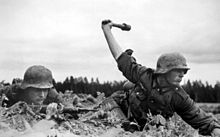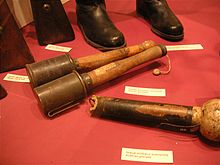- Model 24 grenade
-
The Model 24 Stielhandgranate was the standard hand grenade of the German Army from the end of World War I until the end of World War II. The very distinctive appearance led to its being called a "stick grenade", or a "potato masher" in British Army slang, and is today one of the most easily recognized infantry weapons of the 20th century.[1]
Contents
Design and operation
The stick grenade was introduced in 1915 and the design developed throughout World War I. A friction igniter was used; this method was uncommon in other countries but widely used for German grenades.
A pull cord ran down the hollow handle from the detonator within the explosive head, terminating in a porcelain ball held in place by a detachable base closing cap. To use the grenade, the base cap was unscrewed, permitting the ball and cord to fall out. Pulling the cord dragged a roughened steel rod through the igniter causing it to flare-up and start the five-second fuse burning. This allowed the grenade to be hung from fences to prevent them from being climbed; any disturbance to the dangling grenade would cause it to fall and ignite the fuse.
The first stick grenades featured a permanently revealed pull cord which came out from the handle near the bottom (rather than tucked inside the removable screw-capped base). These exposed pull cords had a tendency to accidentally snag and detonate the grenades while being carried, causing severe (usually fatal) injuries.
Stick grenades were stored in cases for transport, and their fuse assemblies inserted prior to going into combat — a reminder for the user was stenciled on each explosive charge ("VOR GEBRAUCH SPRENGKAPSEL EINSETZEN", in English: "Before use insert detonator").
This type of grenade, featuring a high explosive charge encased in a thin sheet steel can, is an example of an "offensive" (relying on blast effect), rather than "defensive" (fragmentation) grenade. A serrated fragmentation sleeve ("Splitterring") was adopted in 1942 which could be slid over the head of the grenade. Fragments of the sleeve would be scattered on detonation, making the grenade more effective against personnel.
The stick provided a lever, significantly improving the throwing distance. The Model 24 could be thrown approximately 30 to 40 yards, whereas the British Mills bomb could only be thrown about 15 yards.[2] The design also minimized the risk of the grenade rolling downhill back towards the thrower when used in hilly terrain or in urban areas. However, the additional length of the handle meant that fewer could be carried.
The grenades were extremely useful for clearing out entrenched infantry positions. Although they were not individually very effective against armoured vehicles and fortifications, the grenade could be used in an improvised "bundle" style with another six explosive heads (without their sticks) wired around the central stick grenade. These were known as Geballte Ladung (literally "baled charge" or "concentrated charge").
Variants
The Stielhandgranate went through numerous variants, several versions being deployed in World War I before a settled design emerged in 1917. Into World War II the grenade had a slightly smaller head and the unnecessary belt clip was removed.
Each change was essentially a move towards a lighter device which was easier and less costly to manufacture, and to these ends the Model 24 was eventually superseded by the simpler Model 43 grenade, although the former continued to be used through to the end of the war.
Numerous Ersatz variations were developed towards the end of the war as Germany's resources and production capabilities dwindled. Other than the common high explosive (HE) stick grenade, Germany produced a smokescreen version, which existed in an early and later model and is easily identified by a white band around the handle and (on the later model) a grooved handgrip to permit a user to differentiate it from the regular explosive version in the dark by touch alone. As a cold climate could cause the Model 24 to fail to detonate, a special explosive powder was used in those destined for Russia, and these were marked with "K" (Kalt or "cold") on the can. Inert (non-exploding) training versions were also produced.
The stick grenade concept was also used in the Far East by the Imperial Japanese Army and the Chinese National Revolutionary Army in World War II, and later the Chinese Communists, who supplied the locally-manufactured "Type 67" to the NLF and People's Army of Vietnam.
Collecting
German stick grenades were desirable souvenirs for Allied soldiers in World War II, and originals are still much sought after by collectors. There is also a market in replicas, with examples of these being of varied quality and accuracy; many have a fundamentally incorrect profile and are notably lacking in details. In the U.S., the explosive charge and detonator must be removed.
References
See also
- List of World War II firearms of Germany
- Model 39 grenade
- Model 43 grenade
- RGD-33 Grenade
- Splitterring
External links
German firearms and light weapons of World War IISide arms (Pistolen) Mauser C96 · Luger · Walther P38 · Walther PP and PPK · Sauer 38H · Mauser HSc · Dreyse M1907 Pistol · VolkspistoleRifles & carbines (Gewehre & Karabiner) Karabiner 98k · G 24(t) · G 33/40(t) · G 98/40 · Gewehr 41 · Gewehr 43/Karabiner 43 · MP 43/MP 44/StG 44 · FG 42 · M30 Luftwaffe drilling · StG 45(M) · VG 1-5 · Wimmersperg Spz-krSubmachine guns (Maschinenpistolen) Machine guns & other larger weapons MG 08 · VMG-27 · Schwarzlose MG M.07/12 · MG 13 · MG 15 · MG 26 · MG 30 · MG 34 · MG 42 · MG 45 · IMG 28 · MG 35/36A · Faustpatrone · Raketen-Panzerbüchse 43 · Panzerfaust · Panzerschreck · Fliegerfaust/Luftfaust · Flammenwerfer 35 · Einstossflammenwerfer 46 · Panzerbüchse 39 · Solothurn S-18/1000Mortars (Granatwerfer) Grenades (Granaten) Model 24 Stielhandgranate · Model 43 Stielhandgranate · Model 39 Eihandgranate · Splitterring · Panzerwurfmine · HafthohlladungNotable foreign-made infantry weapons German-made cartridges used by the Wehrmacht 8×57mm IS · 7.63×25mm Mauser · 8x33mm Kurz · 7.65×22mm Parabellum · 9×19mm Parabellum · 13.2×92mmSR · 7.92×94mmCategories:- World War I German infantry weapons
- World War II German infantry weapons
- Grenades of Germany
- World War II Chinese infantry weapons
Wikimedia Foundation. 2010.




